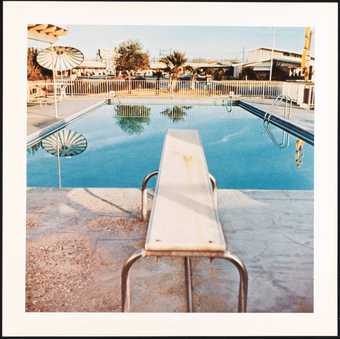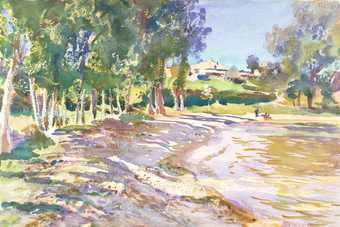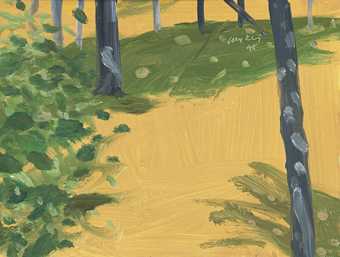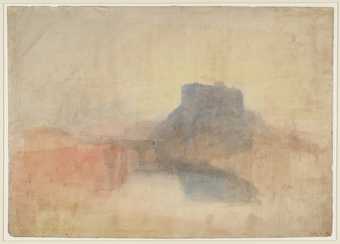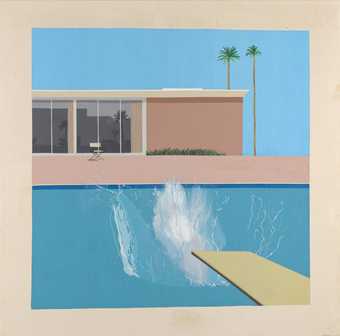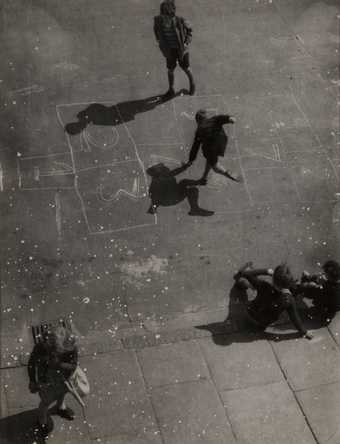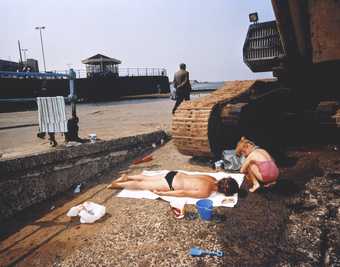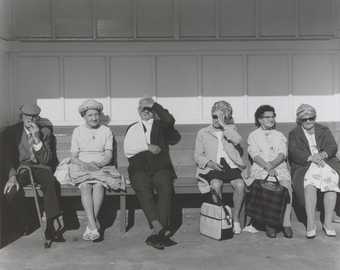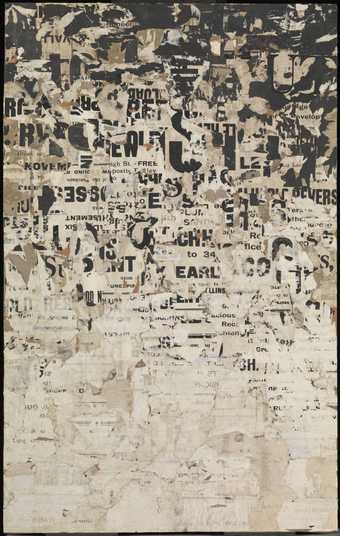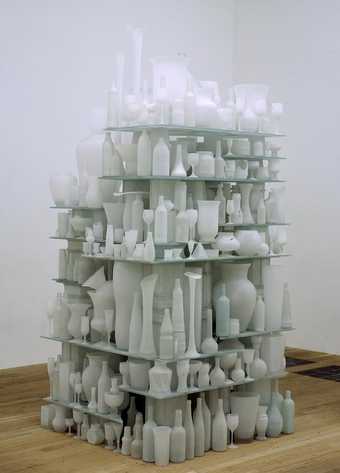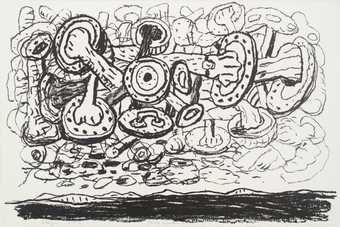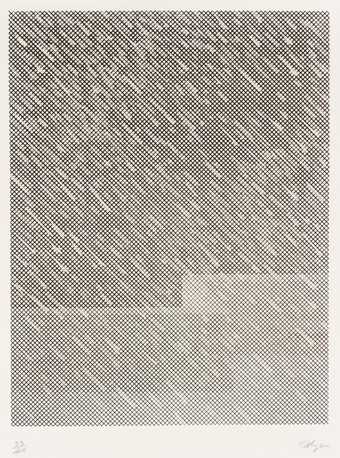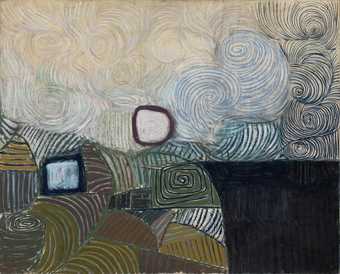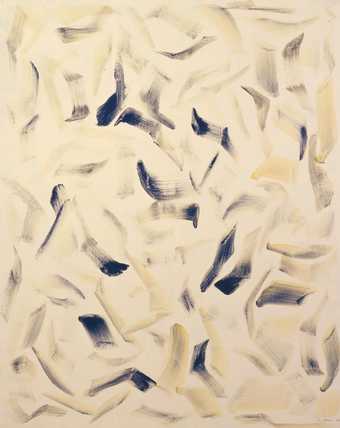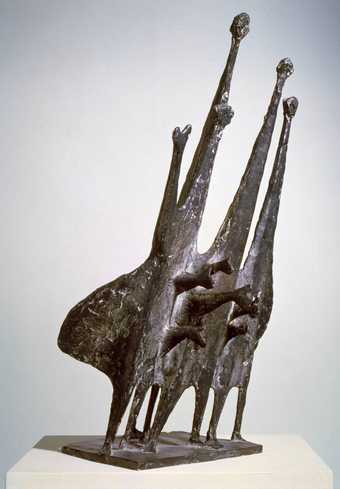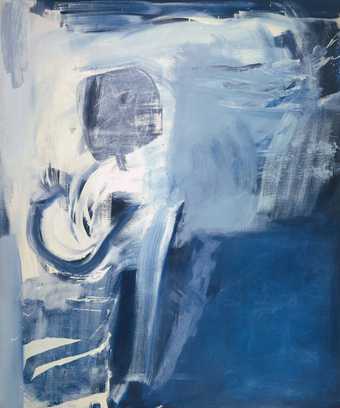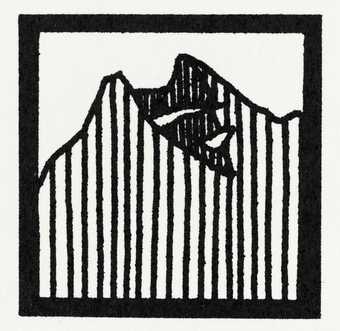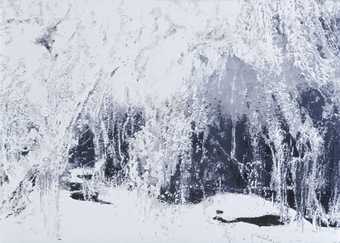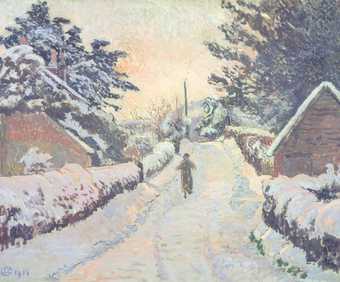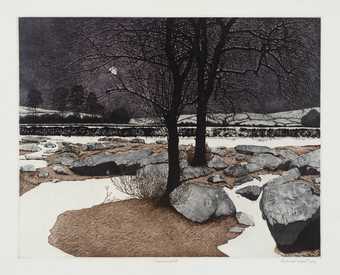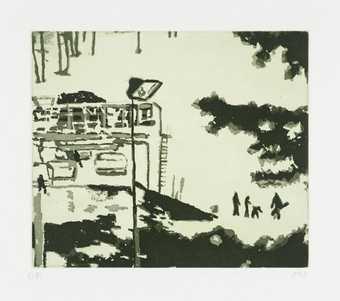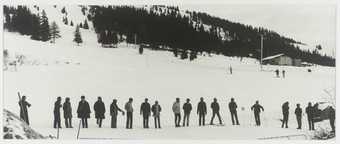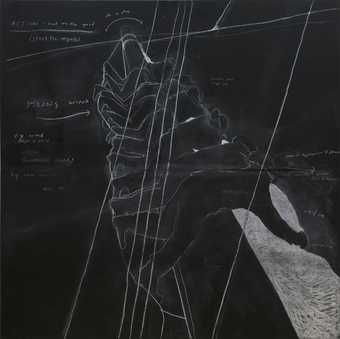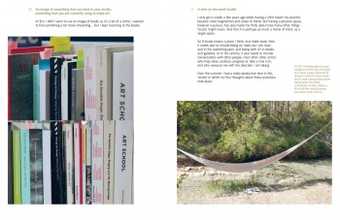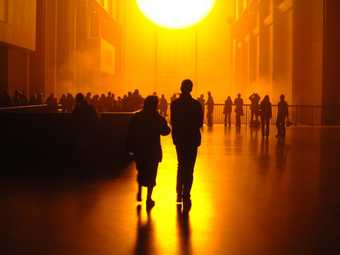
Olafur Eliasson, The Weather Project in the Turbine Hall at Tate Modern 16 October 2003 – 21 March 2004
Introduction
Whatever the weather, artists for centuries have been inspired to make art in response to it. Some explore ways of picturing the wonder of a magical snowy scene or capturing the lazy calm of a sunny day; others experiment with abstract forms and marks to put across how the weather makes them feel.
Contemporary artists such as Tacita Dean, Roni Horn and Susan Hiller have adopted conceptual approaches to exploring ideas in response to weather conditions; while Olafur Eliasson, uses his weather-themed work to raise awareness of the importance of renewable energy.
Sunny Days

Chris Killip
Couple asleep on the sand, South Shields, Tyneside
(1976, printed 2012–13)
Tate
What does sunshine look like? How does its brightness and shadow affect how our streets and landscapes look? How does it make us feel?
Alex Katz perfectly and simply captures a gentle sunny day with the sunlight sparkling on the sea in Penobscot 1999. Painted on a small scale and 'en plein air' (outside and on-the-spot), it feel very much like the artist's immediate response to a sunny moment in time.

Alex Katz
Penobscot
(1999)
ARTIST ROOMS Tate and National Galleries of Scotland
A century before Katz made his painting, the impressionists were busy exploring ways of capturing the effects of sunlight on landscapes and cityscapes. By using dabs of pastel colour and complementary colours to suggest shadow, their landscapes seem flooded with shimmering light, and movement.
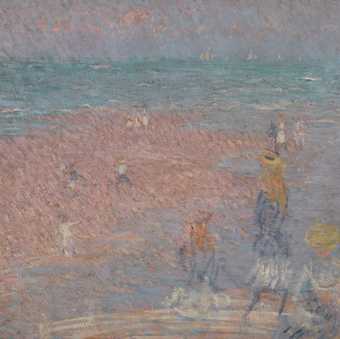
Philip Wilson Steer
Figures on the Beach, Walberswick
(c.1888–9)
Tate
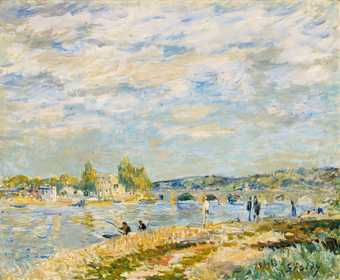
Alfred Sisley
The Bridge at Sèvres
(1877)
Tate

Paul Cezanne
The Gardener Vallier
(c.1906)
Tate
David Bomberg’s painting Trees in the Sun, Cyprus 1948, seems as much about painting the effects and feel of the blistering mediterranean heat as about representing the landscape. Although painted from life, the fiery colours and loose brushstrokes make the painting look like an abstract depiction of sunshine rather than a real life view.
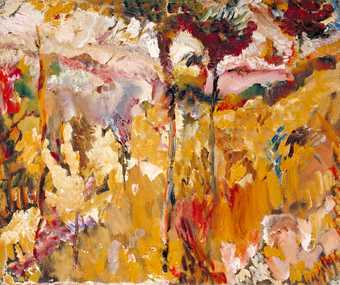
David Bomberg
Trees in Sun, Cyprus
(1948)
Tate
Gillian Ayres and Howard Hodgkin have also painted abstract responses to sunshine. Packed with interlocking, loosely defined shapes and zig-zagging lines; and painted in shades of yellow, red and orange, Gillian Ayres's Phaëthon seems to evoke the happy mood of a sunny day. Howard Hodgkin uses simple shapes to suggest a palm tree and the edge of a pool. The pared down image reflects the simple pleasure of relaxing by a hotel pool.
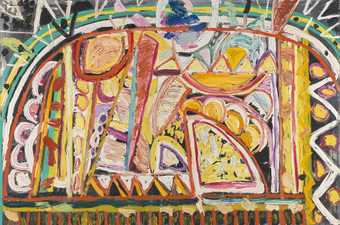
Gillian Ayres CBE RA
Phaëthon
(1990)
Tate
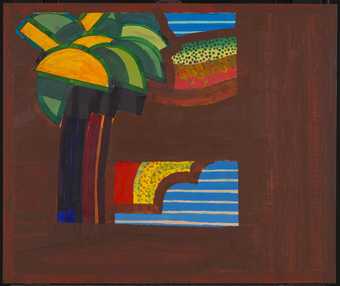
Howard Hodgkin
In a Hotel Garden
(1974)
Tate
Capturing sunshine doesn’t always have to be about using bright, warm colours. This image by Norman Stevens looks like an abstract painting. But Stevens has actually photographed a flight of sun-dappled steps. The lights and darks of the dappled sunshine and shadow perfectly capture the sense of finding a hidden, shady path to wander along and escape the heat of the day.
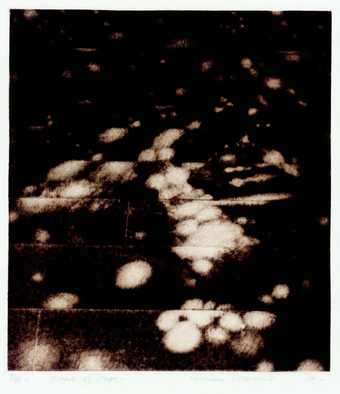
Norman Stevens
Flight of Steps
(1974)
Tate
Explore more artworks that depict sunny scenes and the effects of sunlight, or reflect artists' responses to how the heat of the sun makes them feel:
Kick back and relax!
As well as capturing the effects of sunlight, artists are often inspired by people out and about enjoying the warm weather or lazing in the sun. Henry Matisse’s Reading Woman with Parasol 1921 depicts a relaxed summer day activity, while you can almost smell the sun cream and taste the ice cream in Peter Blake’s painting of the Los Angeles seaside.
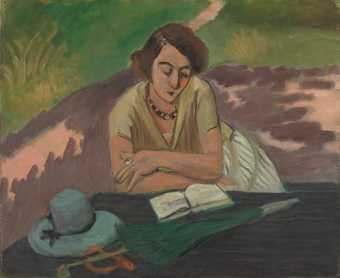
Henri Matisse
Reading Woman with Parasol
(1921)
Tate
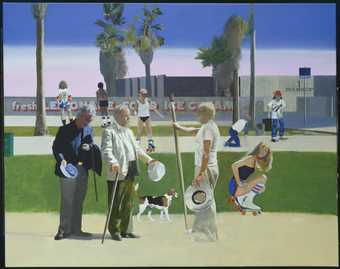
Peter Blake
‘The Meeting’ or ‘Have a Nice Day, Mr Hockney’
(1981–3)
Tate
Photographers Henry Wessel, Chris Killip, Martin Parr, Nigel Henderson and Eileen Agar have snapped people soaking up the rays on beaches, in parks and gardens and on city streets:
Grab your Brolly!
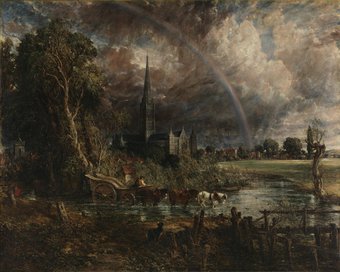
John Constable
Salisbury Cathedral from the Meadows
(exhibited 1831)
Tate
From cloud gazers to storm fiends: discover how cloudy skies, wet days and blustery storms can be inspiring.
Cloudy skies
Clouds are pretty amazing. Not only can we see faces or imagined landscapes in them, but they are also a gauge of what the weather will be. Different types of clouds suggest different weather fronts. Nineteenth century artists Alexander Cozens, John Constable and J.M.W. Turner all made studies of clouds from life. Constable recorded the times of day when he made his sketches, giving his studies a scientific accuracy.
Vija Celmins makes meticulous depictions of skies. But unlike the nineteenth century cloud-gazers, Celmins works from photographs, and uses the subject to explore the processes of drawing, rather than the effects of weather. Viewed from a distance her drawings and paintings of skies and other vast spaces in nature (including oceans and deserts), convey a sense of emptiness and loneliness. But if you look at them close-up, the texture of her marks and the characteristics of the graphite, charcoal and oil paint become mesmerising. Celmins said about her drawing process:
I’ve found a way of building the space, letting in light, keeping the image close to the surface, moving the eye along, with small strokes that keep their integrity.
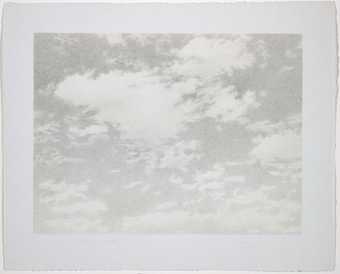
Vija Celmins
Sky
(1975)
Tate
Hans Landsaat abstracts the bulbous rounded shapes of clouds into geometric compositions. But by using pale atmospheric colours and suggesting the bulky shape of a cloud, he manages to put across the sense of a heavy cloudy sky.
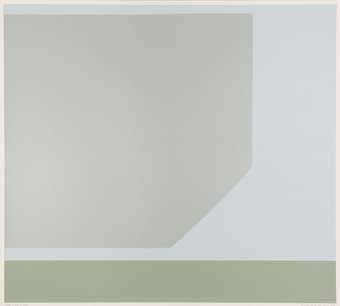
Hans Landsaat
Cloud over Sea
(1979)
Tate
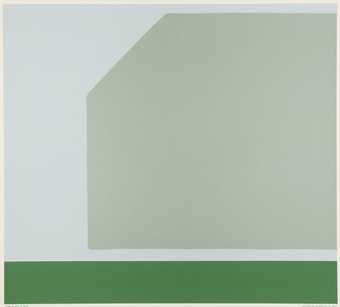
Hans Landsaat
Cloud over Land
(1979)
Tate
Tom Phillips and Richard Long have responded to clouds through text-based artworks. Phillips's cloud shaped bubbles of words suggest the poetry of clouds. Richard Long uses words to describe a walk that he took in the Cairngorms national park in Scotland. In the Cloud describes the moment he walked over Ben Macdui, the tallest peak in the Cairngorms, and records how much time the artist spent enveloped in cloud. (Another text work, A Cloudless Walk 1996, describes a walk determined by the length of time Long walked until he reached a cloud). The text is simple with no extra or unnecessary detail. Long has stated that:
A text is a description, or story, of a work in the landscape. It is the simplest and most elegant way to present a particular idea.

Tom Phillips
[no title: p. 170]
(1970)
Tate

Richard Long CBE
In the Cloud
(1991)
ARTIST ROOMS Tate and National Galleries of Scotland
From breezy to blustery
This delicate artwork by Michael Raedecker shows a clothes line blowing in a breeze. As well as traditional drawing and painting materials, Raedecker uses embroidery thread in his artworks. (You can see the white stitching in some of the cloths hanging from the line). The thread adds texture to the painting surfaces:
There are things happening on the surface of the overall image which hopefully make your eye float around the image ... I always try to find different means for how to use thread ... I don’t fill everything in. I leave room for the viewer to step into the image.
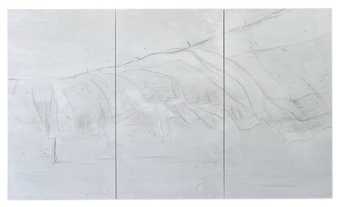
Michael Raedecker
tipping point
(2007)
Tate
Jeff Wall's photograph A Sudden Gust of Wind (after Hokusai) 1993 apparently shows the moment when a gust of wind sweeps a stash of papers into a swirling mass in the sky. But although it looks like a spontaneous image, Wall painstakingly planned the composition. The four figures that appear in the image were photographed over a period of five months in the same landscape at times when there were similar weather conditions. He then collaged elements of the photograph digitally in order to achieve his composition. The result is an intiguing image that looks staged but seems at the same time to capture a moment in time. His sketch for the artwork reveals his working process.
Frank Auerbach uses vigorous scribbly marks to express blustery gales of wind. He made a series of fifty drawings for his painting Primrose Hill 1967-8 which show trees and bits of paper being blown around. The hasty, messy drawings looks as if he sketched them while he was being battered by the wind and responded very directly to how the wind made him feel.

Frank Auerbach
Working Drawing for ‘Primrose Hill’
(1968)
Tate
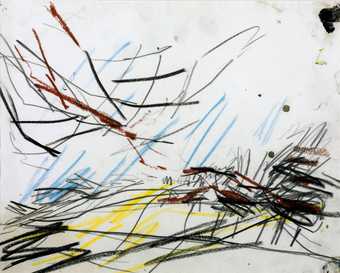
Frank Auerbach
Working Drawing for ‘Primrose Hill’
(1968)
Tate

Frank Auerbach
Working Drawing for ‘Primrose Hill’
(1968)
Tate
Rain Rain Rain
J.M.W. Turner created hundreds of sketches and paintings capturing different weather conditions. In these two atmospheric sketches, he uses washes of watercolour and thicker brushstrokes of gouache paint to suggest the gathering clouds and lashing rain over a landscape and a seascape.
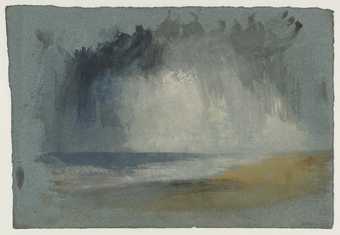
Joseph Mallord William Turner
Beach, ?English Coast
(c.1835–40)
Tate
Artists Julian Opie and Gerhard Richter have painted the effects of rain on urban streets. Opie's digitally altered photograph of the rain at night shows streetlights and car headlights reflected in the wet surface of street and pavement. Opie removed details and blocked in areas of the night sky making this picture or a rainy street at night seem universal – it looks like any street.
Although the title of Richter's painting suggests it is an abstract work, the colours he has used and the technique of blurring the paint using a squeegee suggests the colours and bustle of an urban setting. Curator Richard Cork has decsribed the blurred forms as reflections produced by ‘figures, buildings and traffic’ on a ‘rain-soaked street’.
Explore more approaches to cloudy skies, chilling winds and rainy days:
Let it snow!
There is something magical about snow. This magic is captured by Peter Doig in his painting Ski Jacket 1994. The tints of pastel colour and flecks of paint dotted onto the surface of the painting make the image appear to sparkle. The buzz of tiny figures scattered around the mountain conjures up the excitement of people out enjoying the snow.
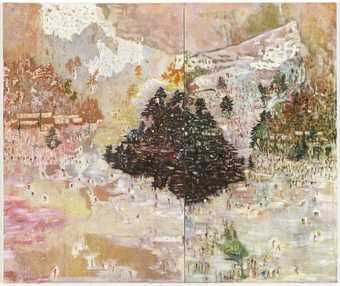
Peter Doig
Ski Jacket
(1994)
Tate
Paul Nash has painted the snow in the garden of his home. Although not as spectacular as Doig’s huge mountain vista, Nash's grotto also captures snow's magic. The gentle dusting of snow on the trees and house looks like icing. The grotto, a small cave-like structure buried by a mound of snow, seems mysterious.

Paul Nash
Grotto in the Snow
(1939)
Tate
J.M.W. Turner’s depiction of snow presents a very different picture. A boat is terrifyingly caught in the vortex of a snow storm. The whirling cloud of snow and whipped-up sea almosts envelops it. The painting looks almost abstract. Turner said that he wasn’t trying capture what a storm looked like but what it felt like: 'I did not paint it to be understood, but I wished to show what such a scene was like'. In order to fully experience the terrifying power of nature he asked to be lashed to the mast of a boat during a storm, risking his life.
I got the sailors to lash me to the mast to observe it; I was lashed for four hours, and I did not expect to escape, but I felt bound to record it if I did.
As well as evoking nature's power, the painting can also be interpreted as a symbol of mankind’s futile efforts to combat the powerful forces of nature.
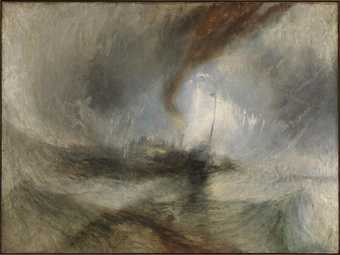
Joseph Mallord William Turner
Snow Storm - Steam-Boat off a Harbour’s Mouth
(exhibited 1842)
Tate
Artist Willhelmina Barns Graham also uses abstraction to capture the power – as well as the beauty – of nature in her depiction of a Glacier. The icy colours she has used makes you shiver with cold just looking at this painting!
This one of several works painted by Barns Graham following a visit to the Grindelwald Glacier in Switzerland in 1948. She wanted to capture the glacier’s monumental shape, its light, and the contrast between solidity and glass-like transparency. For her depiction she combined multiple views ‘from above, through and all round, as a bird flies, a total experience’.
Explore more wintry art in Tate's collection:
Weather: Meanings, Moods and Warnings
The weather as a subject has fascinated artists for centuries, but contemporary artists are still finding news ways of responding to it.
Susan Hiller and Tacita Dean have used stormy seas to explore ideas around the representation of dramatic weather conditions.
Tacita Dean's The Roaring Forties: Seven Boards in Seven Days is a series of drawings on blackboards that evoke the look of early black and white films. As well as suggesting a golden age of Hollywood cinema, The Roaring Forties is the name given to a zone in the southern Atlantic, between 40º and 50º latitude, which is noted for its gale-force winds. Based on old photographs Dean constructed an epic sea narrative in seven parts. It includes scenes of a storm, a ship under full sail listing with the wind and a series of muscled figures engaged in such activities as rowing a skiff or climbing in rigging. As well as the dramatic pictures drawn in black and white, the hand-written notes that punctuate them also suggest cinema. Instructions such as 'aerial view', 'fade up from black' and 'pan to action from out of frame' are the sort of instructions used by film directors in film making.
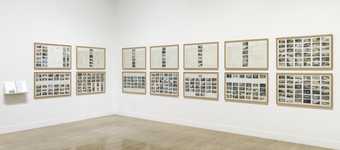
Susan Hiller
Dedicated to the Unknown Artists
(1972–6)
Tate

Susan Hiller Dedicated to the Unknown Artists (detail) 1972–6
305 postcards, charts, maps, one book, one dossier, mounted on fourteen panels
Photo: Todd White Art Photography
Susan Hiller's Dedicated to the Unknown Artists features over 300 found postcards depicting stormy waves crashing onto shores around Britain. The artwork includes a large map marked with each of the locations featured in the postcards. The spectacular nature of the weather is contrasted with the mundanity of these throwaway postcards. The title of the work suggests that Hiller is paying tribute to the overlooked and forgotten artists who painted, photographed or hand-tinted these numerous seaside images.
Artist Roni Horn's fascination with the weather and its effects has led to her making lots of work about the landscape in Iceland, a country where the extremes of the winter weather dominates its environment. Her print Water, Selected, 2007 shows a detailed map of labeled with the places where water from glaciers can be found. This is part of a larger project for which Horn has collected an ‘archive’ of water from twent four glacial sources across the country.
Roni Horn's You are the Weather 1994–5, is a series of 100 close-up photographs of a woman, situated in the hot springs and pools in Iceland. In each image, the woman’s facial expressions change with the changes in the weather conditions around her. Horn said about the work: 'The way this work is shot and installed...You are surrounded by a woman who is staring at you’. This suggests that the viewer takes the place of the weather to which the young woman is responding.
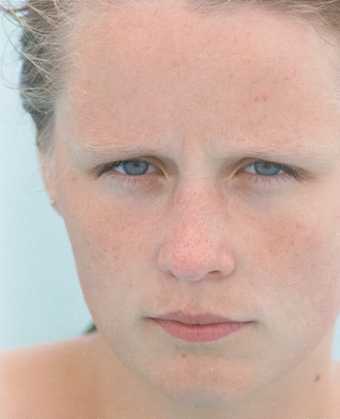
Roni Horn You are the weather 1994–5
64 C-prints and 36 gelatin-silver prints
Courtesy Hauser & Wirth Zürich London
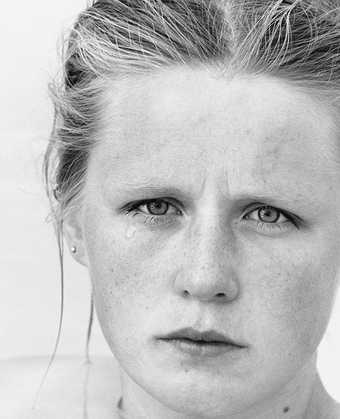
Roni Horn You are the weather 1994–5
64 C-prints and 36 gelatin-silver prints
Courtesy Hauser & Wirth Zürich London

Roni Horn You are the weather 1994–5
64 C-prints and 36 gelatin-silver prints
Courtesy Hauser & Wirth Zürich London
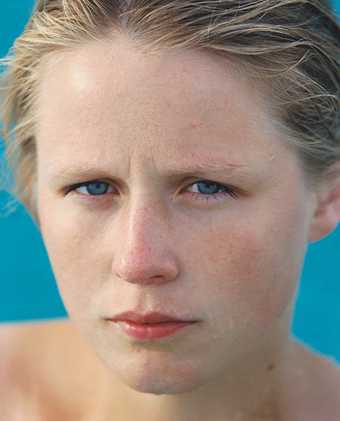
Roni Horn You are the weather 1994–5
64 C-prints and 36 gelatin-silver prints
Courtesy Hauser & Wirth Zürich London
In 2003-4 artist Olafur Elliason brought the sun into Tate Modern in his installation The Weather Project. In the installation representations of the sun and sky dominate the expanse of the building's Turbine Hall. A fine mist spreads through the space, as if creeping in from the environment outside. Throughout the day, the mist accumulates into faint, cloud-like formations, before dispersing across the space. In making the work Elliason was interested in exploring ideas about the viewer's experience and their connection with what they are experiencing. When The Weather Project was shown at Tate Modern, many visitors spontaneously lay on the floor looking up in order to experience the power of the work.
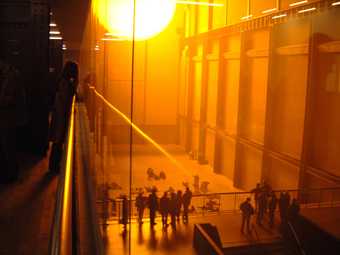
Olafur Eliasson, The Weather Project in the Turbine Hall at Tate Modern 2003–2004
In 2010 Eliasson developed his project Little Sun, a solar-powered light (in the shape of a sun) that he took to off-grid areas of the world (areas where there is no electricity). In 2012 Eliasson brought Little Sun to an exhibition at Tate Modern. Visitors learnt about solar power, the global energy challenge, light and its importance in and for life. The exhibition also included special blacked-out areas for people to create light graffiti using the Little Sun.
Find out more about Eliasson's weather-related artworks, and watch some spectacular light-graffiti made using the light from Little Sun!

